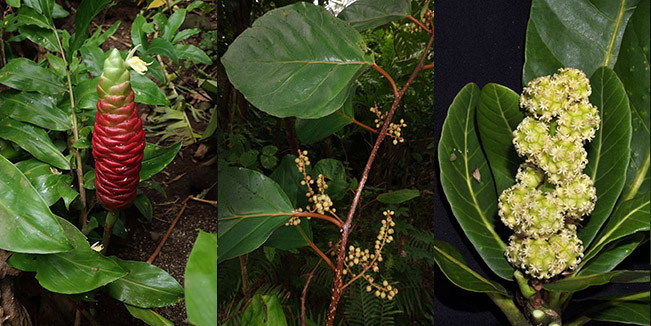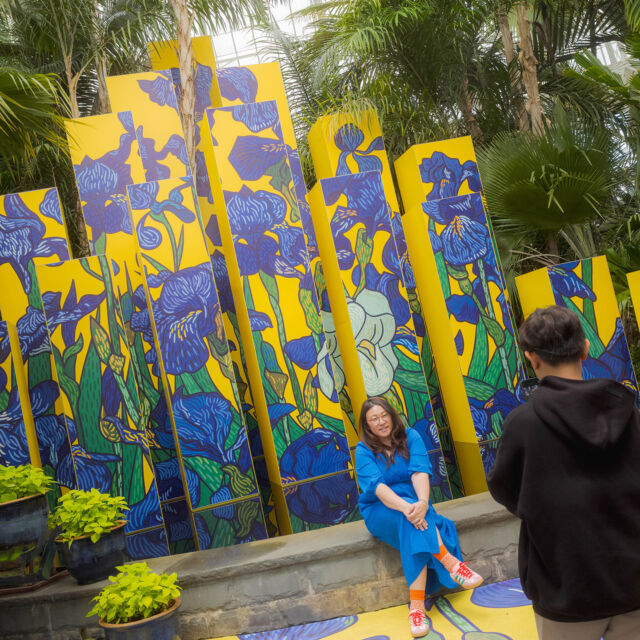How Plants Are Used in Centuries-old “Weather Magic” Practices on Islands in the Southwestern Pacific Nation of Vanuatu
Michael J. Balick, Ph.D., is Vice President for Botanical Science and Director and Senior Philecology Curator of the Institute of Economic Botany, and Gregory M. Plunkett, Ph.D. is Director and Curator of the Cullman Program for Molecular Systematics at The New York Botanical Garden.

Species of plants used in weather magic practices in southern Vanuatu include plants known locally as (left to right) mari mari (Zingiber zerumbet), namap (Maesa sp.), and karuarua (Meryta neoebudica). Photos by Gregory M. Plunkett, Ph.D.
Together with a group of colleagues in the United States and in Vanuatu, we recently published a study on how plants are used in “weather magic,” representing centuries-old rituals and other practices intended to understand and even influence the weather, on two islands in the Southwestern Pacific nation of Vanuatu. Before you roll your eyes and wonder why we studied something that local specialists in weather and climate call “magic,” you should know that in Vanuatu, this term has a different meaning than it does in the West. Local people (called Ni-Vanuatu) use this word to refer to the domain of knowledge relating to weather and climate, which comprises a critical repository of sophisticated Indigenous environmental knowledge, particularly knowledge about plants. This holistic system of belief, expertise, and practice supports human well-being and resilience, particularly in the face of changing climate. We presented our findings, the result of eight years of field and literature research, in a peer-reviewed paper, “Weather Magic as Environmental Knowledge in Southern Vanuatu,” recently published in the Journal of Ethnobiology.
We carried out the study on the volcanic islands of Tanna and Aneityum, in Tafea Province at the southern end of Vanuatu. The traditional concept of weather magic is aimed at influencing a wide variety of meteorological conditions, such as starting or stopping rain, causing winds to blow, bringing out the sun, or calming the seas. It also has a predictive element, such as understanding the severity of the cyclone season and how to prepare for it. Plants are a major part of the rituals involved with weather magic in Tafea Province. For example, the plant known on Tanna as mari mari (Zingiber zerumbet), a member of the ginger family, is used in a rain-making ritual in which a weather tupanas—a magic practitioner focused on weather—ties a large bunch of the wild ginger’s leaves in a bundle along with branches of namap (Maesa sp.), a member of the primrose family. The tupanas then places the bundle in the sea, and when the leaves start to rot (in about a week), rain will come, according to local residents who are steeped in weather-magic lore and practices. Karuarua (Mertya neoebudica), which belongs to the same plant family as ginseng, is intended to have the opposite effect—stopping the rain. When a tupanas places four of its branches in a cross formation and washes them in sea water, he calls for the rain to stop, and then hangs the branches in a tree for five days.
We suggest the detailed knowledge that weather-magic practitioners on these islands hold regarding their local environment represents an important means of transmitting not only cultural heritage but also botanical knowledge, the maintenance of which may be critical for current and future conservation efforts. In addition, the detailed understanding of weather patterns—for example, through observation of the shape and appearance of clouds and shifts in the direction of winds—helps to support resilience and livelihoods on these remote islands.
Despite scientists’ increasing recognition that environmental knowledge is conveyed through a diverse array of Indigenous systems, such as music, magical practice in general has received little attention as a vehicle for such knowledge. In Vanuatu, weather magic is a central part of a larger corpus of magical practices and lore, which, along with traditional systems of governance and worship, are essential parts of what is called kastom in the local Bislama language, meaning custom. Through these practices, weather specialists also can help to guide people on the islands of Vanuatu to prepare for ever-increasing catastrophic environmental events such as cyclones. For example, they can direct people to construct special houses made of local plant materials that are able to resist high winds more effectively than Western-style homes made with cinder block walls and corrugated-metal roofs.
In the course of our field work between 2014 and 2021, we recorded narratives with Indigenous weather magic practitioners and experts, three of whom (Reuben Neriam, Johnson Noar, and Jean-Pascal Wahe) are co-authors on the paper. We collected and identified herbarium specimens of nearly 4,000 plants. Of these, we documented that at least 26 are used in weather magic on land and sea. Most of these plants are native or naturalized plants found growing in the wild. Practitioners must know when and where to find them and how to properly harvest them. Some of the practices that involve weather magic are “generalist” knowledge well known to a wide cross section of the population while others are passed on in secret, to be learned and practiced only by those who inherit the right.
We also suggest that the proper recognition and incorporation of all Indigenous knowledge systems, including magic, will ensure that environmental conservation efforts are as well informed as they can be. Non-Western cultures often see magic as part of a continuum of political, social, and religious beliefs and practices, and, in the paper, we note that “weather magic, culture and environmental knowledge are tightly connected,” and explain that “magic in southern Vanuatu is a lens through which people know and learn about the world around them, and the associated histories and stories reinforce an intimate relationship to environment and place.”
Our work is part of NYBG’s broader Plants and People of Vanuatu project, a multidisciplinary program that involves a diverse group of plant scientists, ethnobotanists, mycologists, cultural specialists, and linguists, including staff at the Vanuatu Forestry Department and Vanuatu Cultural Center. The project’s objective is to study and preserve plants, fungi, ethnobotanical and ethnomedical knowledge, cultural practices, and plant-related language information in Vanuatu, a country that is both a hotspot of biodiversity and also the most linguistically dense country in the world per capita, with an estimated 138 languages spoken by a population of just 270,000.
“Weather Magic as Environmental Knowledge in Southern Vanuatu” is available here.
We are grateful to the following funders for support of Plants and People of Vanuatu: U.S. National Science Foundation under grants No. 1555657 (Principal Investigator Michael J. Balick) and 1555675 (Principal Investigator K. David Harrison) and by Grant No. 1288 from Velux Stiftung, as well as the National Geographic Society, the Christensen Fund, the Marisla Foundation, the Gildea Foundation, Franklinia Foundation, and the Silicon Valley Community Fund. This work was carried out under a research license from the Vanuatu Department of Environmental Protection and Conservation, Forestry Department, and Vanuatu Cultural Centre.
SUBSCRIBE
Enter your email address to subscribe to this blog and receive updates on new posts.











